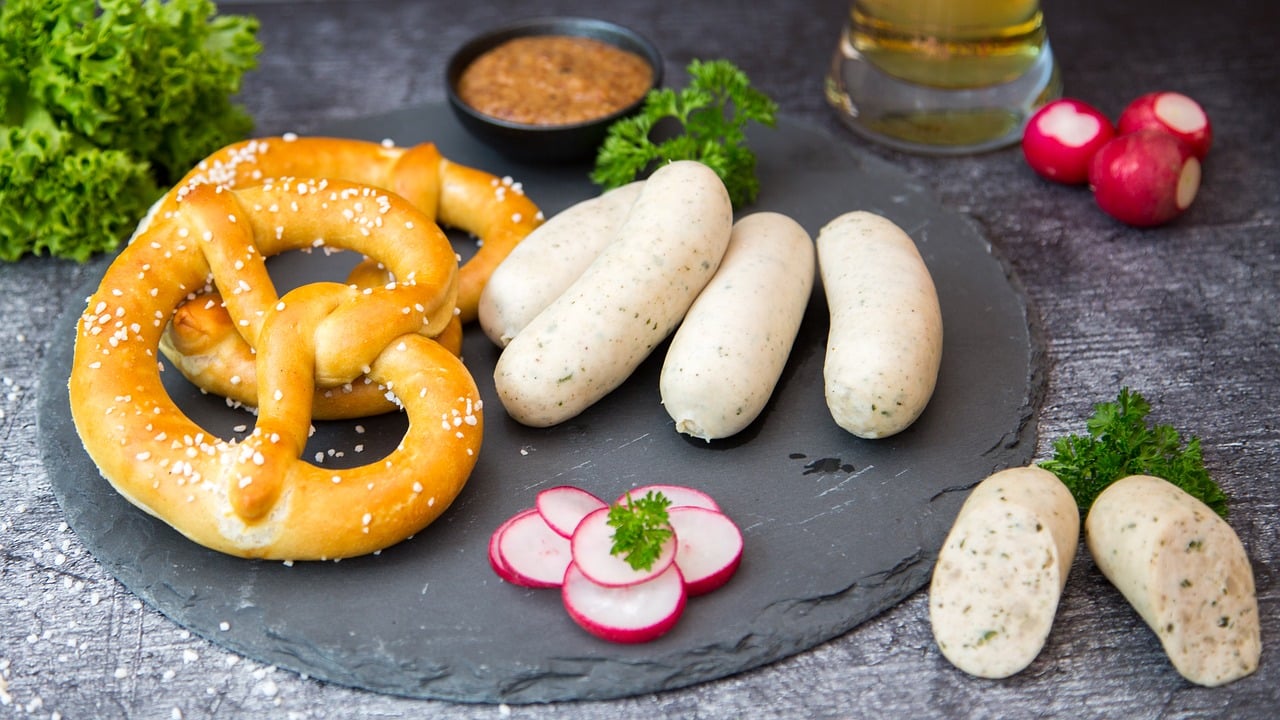
Germany is renowned for its rich culinary heritage, and one of its most cherished contributions is the Weißwurst. This traditional Bavarian white sausage, a staple in Munich and a highlight of Oktoberfest, has been savored since the 19th century. This article will guide you through the process of making Weißwurst at home, including tips on ingredients, preparation, and serving, bringing a taste of Bavaria right to your kitchen.
Ingredients
To make authentic Weißwurst, you’ll need:
- 2.5 lbs (1.1 kg) of veal shoulder, finely ground
- 0.5 lbs (225 g) of back bacon (or pork back fat), finely chopped
- 1 cup (240 ml) of ice water
- 1 large egg white
- 2 teaspoons (10 ml) of kosher salt
- 1 tablespoon (15 ml) of fresh parsley, finely chopped
- 1 teaspoon (5 ml) of white pepper
- 1 teaspoon (5 ml) of mustard seeds, crushed
- 1/2 teaspoon (2.5 ml) of mace
- 1/2 teaspoon (2.5 ml) of cardamom
- 1/2 teaspoon (2.5 ml) of lemon zest
- Sausage casings (preferably natural hog or sheep casings)
Equipment
- Meat grinder
- Large mixing bowl
- Sausage stuffer
- Large pot for poaching
Preparation
1. Grinding the Meat and Fat
Start by grinding the veal shoulder and back bacon. For the best texture, it’s crucial to keep the meat and equipment cold. Place the meat and the grinder parts in the freezer for about 30 minutes before grinding.
2. Mixing the Ingredients
In a large bowl, combine the ground meat and fat. Gradually add the ice water and egg white, ensuring the mixture remains cold. This is key to a smooth and emulsified texture. Add the salt, parsley, white pepper, crushed mustard seeds, mace, cardamom, and lemon zest. Mix thoroughly until the ingredients are well combined and the mixture becomes sticky. This is important for the sausages to hold together well.
3. Stuffing the Sausages
Soak the casings in warm water to make them more pliable. Run water through them to ensure they are clean and to identify any holes. Using the sausage stuffer, carefully fill the casings with the meat mixture. Avoid overstuffing to prevent the sausages from bursting during cooking. Twist the sausages into 4-inch lengths.
4. Poaching the Weißwurst
Fill a large pot with water and heat it to just below boiling (around 160°F or 70°C). Gently place the sausages in the water and poach them for about 20-25 minutes. It’s important not to let the water boil, as this can cause the sausages to burst.
5. Serving
Traditionally, Weißwurst is eaten before noon with sweet mustard, freshly baked pretzels, and a cold beer. The sausages are usually heated in water but not boiled, as this could cause the casing to burst. Remove the Weißwurst from the water, and serve immediately.
Tips for the Perfect Weißwurst
- Quality of Meat: Use high-quality veal and pork for the best flavor.
- Grinding: Keep everything cold during grinding to prevent fat smearing.
- Seasoning: Be generous with seasonings to achieve the authentic Bavarian taste.
- Cooking: Never boil the sausages; gentle poaching is key.
Serving Suggestions
- Traditional Bavarian Breakfast: Serve with sweet mustard, pretzels, and a wheat beer for a classic Bavarian breakfast.
- Oktoberfest Feast: Pair with sauerkraut, potato salad, and a stein of your favorite beer.
- Modern Twist: Try serving Weißwurst with a variety of mustards or even a curry sauce for a contemporary take.
Making Weißwurst at home is a delightful way to explore German cuisine. While it requires some effort, the result is a delicious, authentic taste of Bavaria that’s perfect for special occasions or a hearty breakfast. Whether you’re celebrating Oktoberfest or simply enjoying a weekend brunch, this Weißwurst recipe is sure to impress.
FAQs
- Can I freeze Weißwurst? Yes, you can freeze the uncooked sausages for up to two months.
- What if I don’t have a meat grinder? You can ask your butcher to grind the meat for you.
- Is there a vegetarian alternative? Traditional Weißwurst is meat-based, but you can find plant-based versions in some specialty stores.
- Can I cook Weißwurst in beer? Yes, poaching in beer adds a unique flavor, but it’s not traditional.
- How do I know when the sausages are done cooking? They should be firm to the touch and a thermometer should read 160°F (71°C).
Enjoy your homemade German Weißwurst and the taste of Bavarian tradition!
Related Recipes:
German Knackwurst Recipe
German Wurst Guide
German Blutwurst Recipe
Liverwurst
Bratwurst
Classical German Sausage
German Sausage with Apples Sauerkraut and Onion
German Sausage Soup
Strange German Foods Tourists Don’t Understand
